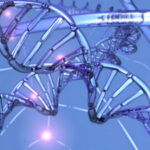There are many wonderful techniques in the medical sciences today to help with new medical discoveries and help diagnose illnesses. Understanding of Genetics has helped scientists understand human genetic disorders and the microorganisms and viruses that can make us ill. The techniques listed below show some of the techniques used in genetic/molecular biology laboratories today to help in understanding the genetics of humans and many other organisms.
DNA Gel Electrophoresis
This procedure can be used to measure length and the purity of DNA molecules. DNA, which is loaded in the agarose gel well, is exposed to electric current. The electric current causes the DNA to pass through the pores of the agarose gel and become separated according to its chemical properties. Once this is completed, the gel can then be analyzed by scientists.
SDS Polyacrylamide-Gel Electrophoresis
This procedure is used to separate and analyze proteins. In this procedure, an electromagnetic field is applied to the protein in the polyacrylamide gel. This electromagnetic field causes the protein to move through the pores in the gel according to its unique chemical properties. Once the procedure is done, the gel is ready to be analyzed by scientists.
X-ray Crystallography
X-ray crystallography examines the 3-D structure of molecules by determining the diffraction pattern of the protein crystal. The diffraction pattern is determined by applying beams of X-rays to the protein crystal. Scientists use the diffraction pattern and amino acid sequences to determine the molecule shape.
Nuclear Magnetic Resonance Spectroscopy (NMR)
NMR studies small molecules and proteins. In this procedure, a small amount of concentrated protein solution is placed in a strong magnetic field. When in the strong magnetic field, scientists use machines to observe the behavior of atomic nuclei, which emit certain observable radiation. The results of this test are used along with the known amino acid sequence to compute the 3-D shape of the protein.
Polymerase Chain Reaction (PCR)
This procedure is what makes rapid cloning of short DNA strands possible. First, the scientist chooses what to amplify and creates primers accordingly. Then, the scientist puts primers and DNA strands into a mixture which contains DNA polymerase, dATPs, dGTPs, dCTPs, and dTTPs. The solution is then put in the PCR machine so replication can begin. There are three stages in PCR cycles. Usually, PCR goes through these stages (1 cycle) about 20-30 times.
Cycles
1. Denature DNA
In this step, high temperatures separate DNA in single strands.
2. Anneal primers
The primers bond with the DNA strand.
3. Extended primers
DNA polymerase begins to synthesize DNA on the strand.
PCR produces thousands of clones of the original DNA strand. This procedure is perfect for scientific research and forensics because it gives scientists many of the desired DNA sequence to work within an experiment.
PCR Used in Forensic Science
There are unique repeating DNA sequences in different parts of the human genome. Sometimes, investigators use PCR to replicate DNA sequences found at the crime scene. Once the DNA is cloned using PCR, the DNA is compared with all the different suspects’ repeating DNA sequences using electrophoresis. The repeating sequence that matches the DNA collected at the crime scene shows whose DNA matches the sequence in question. These repeats could be referred to as “fingerprints” of an individual.
DNA sequencing
DNA sequencing uses a method called the dideoxy method. Special components of this procedure, dideoxyribonucleoside triphosphates, do not have the -OH end that DNA polymerase requires for DNA replication. This is very important in the later sequencing steps. These are the following steps of DNA sequencing.
1. DNA is heated and separates into single strands.
2. The single strands are then mixed with radioactive primers which all bind to the 3′ end of the strands.
3. There are four tubes of this solution. Each tube receives DNA polymerase and the four deoxynucleotide phosphates. Each tube receives one type of dideoxyribonucleotide.
4. DNA polymerase begins synthesizing DNA using the single stranded DNA strands added at the beginning of the procedure as a template.
5. As replication goes on, some dideoxynucleotide gets inserted instead of a deoxyribonucleotide in a strand. The dideoxyribonucleotide does not have an -OH group. Therefore, replication terminates at the dideoxyribonucleotide.
6. DNA fragments from each tube are then placed in separate lanes in agarose gel. Then, the fragments are separated by gel electrophoresis.
7. DNA sequence can now be determined by band sequences in the gel. The band sequences are caused by the radioactive primers.
Southern Blot
This procedure can be used to find DNA with wanted sequences, calculate size of DNA fragments, and see if DNA has all or part of gene of interest. This is the follow protocol for the southern plot procedure.
1. The cut DNA fragments undergo gel electrophoresis which causes the DNA to become separated. Cut DNA fragments are created by special enzymes to cut certain DNA sequence fragments, if needed.
2. DNA fragments are transferred to a filter through the blotting technique.
3. Filter is placed in heat-sealed bag with probe.
4. Probe bonds with complementary sequences.
5. The unbound probes are washed away from the filter.
6. Once filter is dry, a X-ray film is put over the filter to create an autoradiogram.
7. Scientists study the audiogram to see which fragments have the sequence of interest. The bands of the DNA fragments with the sequence show clearly because the probe that bonded to them is radioactive.
Northern Blot
This procedure tests for the presence of mRNA to see if gene is transcriptionally active. This procedure runs about the same protocol of the southern blot, but the presence of mRNA is tested. This procedure can be used to test mRNA products from cancer or genetic diseases.
Western Blot
In this procedure, proteins are exposed to antibodies with radioactive isotopes. The antibodies attack the desired protein in solution. The radioactive isotope then reveals the protein in interest under observation. This procedure runs about the same protocol as the southern blot.
Sources
Alberts, Bruce, and Alexander Johnson. Molecular Biology of the Cell. 5th ed. New York: Garland Science, 2008. Print.
Klug, William S., and Michael R. Cummings. Genetics. 8th ed. Upper Saddle River, NY: Prentice Hall, 2006. Print.


